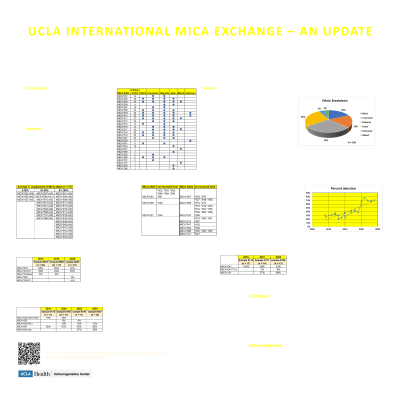Back

UCLA International MICA Exchange – an Update
(P612) UCLA International MICA exchange – An update
Location: Platinum Ballroom

Poster Presenter(s)
Aim: Increased interest in MICA (MHC class I chain-related gene A) antibodies and the role they play in triggering alloimmune response in solid organ transplants emphasizes the growing need of reliable platforms for MICA genotyping. In this study, we evaluated the average percent assignment of MICA alleles among labs using various methodologies to aid in the standardization of MICA allele assignments.
Method: In 2007, the UCLA Immunogenetics Center developed a proficiency testing program for MICA genotyping. This update documents the evolution of MICA genotyping from 2009 – 2023 following the first 2 years of the program. Data collected from participants in the Exchange included MICA genotypes, typing method, and kit information.
Results: From 2009 - 2023, participants examined a total of 180 DNA samples. Among them, 25 different MICA alleles were examined, including MICA*101 and MICA*266. Two new alleles were also identified, MICA*018new and MICA*041new. Thirteen alleles had an average % assignment of ≥ 90%, and 9 alleles had an average % assignment of 51 – 90% (Table 1). The average assignment of MICA*002 (39%), MICA*009 (46%), and MICA*027 (50%) remained low, as labs were unable resolve each from among other alleles (Table 2). Despite their low assignments, overall % assignment of each allele improved over the years due to the advent of NGS (next generation sequencing) typing for MICA. For example, in 2009, MICA*002 was assigned by only 31% (5 of 16). In 2023, the percent detection of MICA*002 increased to 69% (11 of 16). Among the 11 labs reporting MICA*002 in 2023, 9 labs indicated NGS as the method type.
Conclusion: With more labs performing NGS, we observed an increase in the percent assignment of MICA alleles and less assignment of ambiguities, compared to the early years of the MICA Exchange. However, there is still room for improvement. Only 52% (13/25) of the alleles examined achieved an average percent assignment of > 90%. The UCLA International MICA Exchange continues to provide opportunities for laboratories to validate their typing kits and to identify limitations in the various typing methods, thus improving the reliability and resolution of MICA genotyping.
Method: In 2007, the UCLA Immunogenetics Center developed a proficiency testing program for MICA genotyping. This update documents the evolution of MICA genotyping from 2009 – 2023 following the first 2 years of the program. Data collected from participants in the Exchange included MICA genotypes, typing method, and kit information.
Results: From 2009 - 2023, participants examined a total of 180 DNA samples. Among them, 25 different MICA alleles were examined, including MICA*101 and MICA*266. Two new alleles were also identified, MICA*018new and MICA*041new. Thirteen alleles had an average % assignment of ≥ 90%, and 9 alleles had an average % assignment of 51 – 90% (Table 1). The average assignment of MICA*002 (39%), MICA*009 (46%), and MICA*027 (50%) remained low, as labs were unable resolve each from among other alleles (Table 2). Despite their low assignments, overall % assignment of each allele improved over the years due to the advent of NGS (next generation sequencing) typing for MICA. For example, in 2009, MICA*002 was assigned by only 31% (5 of 16). In 2023, the percent detection of MICA*002 increased to 69% (11 of 16). Among the 11 labs reporting MICA*002 in 2023, 9 labs indicated NGS as the method type.
Conclusion: With more labs performing NGS, we observed an increase in the percent assignment of MICA alleles and less assignment of ambiguities, compared to the early years of the MICA Exchange. However, there is still room for improvement. Only 52% (13/25) of the alleles examined achieved an average percent assignment of > 90%. The UCLA International MICA Exchange continues to provide opportunities for laboratories to validate their typing kits and to identify limitations in the various typing methods, thus improving the reliability and resolution of MICA genotyping.

